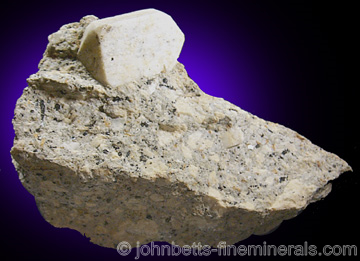The Mineral sanidine

Sanidine is polymorphous with Orthoclase and Microcline. These three minerals form the Potassium Feldspar group.They are almost identical in physical properties, and sometimes it is impossible to distinguish one another without x-ray analysis. The only difference between them is their crystal structure. Microcline crystallizes in the triclinic system, and Orthoclase and Sanidine crystallize in the monoclinic system. Sanidine forms at high temperatures and has a disordered monoclinic symmetry, whereas Orthoclase forms at low temperatures and cools slowly, forming more ordered monoclinic crystals.
In some mineral reference guides, Microcline and Sanidine are wrongly
categorized as variety of Orthoclase. Since it is so difficult to
distinguish between Orthoclase, Sanidine, and Microcline, they may be
simply called "Potassium Feldspar".
Chemical Formula
KAlSi3O8
Color
Colorless, white, cream, yellow, gray, light brown
Crystal System
Monoclinic
Properties
Streak
White |
Hardness
6 |
Transparency
Transparent to translucent |
Specific Gravity
2.5 - 2.6 |
Luster
Vitreous to pearly |
Cleavage
1,1 - basal ; 2,1 - prismatic The cleavage angle is about 90º |
Fracture
Conchoidal to uneven |
Tenacity
Brittle |
Uses
A transparent, yellow variety of Sanidine (previously thought to have been Orthoclase) is used as a gemstone. It is still called Orthoclase on the gemstone market. See the gemstone Orthoclase for additional information.
Noteworthy Localities
Good crystals of Sanidine are not nearly as common as the other potassium feldspars. European localities include Roc de Courlande, Chastreix, France; Drachenfels, Konigswinter, Germany; Capo d'Enfola, Elba, Italy; and Kakourou, Aridhaia, Greece. In the U.S., Sanidine comes from the Ragged Mountain, Gunnison Co., Colorado; the Black Range, Grant Co., New Mexico; the Sandia Mts., Bernalillo Co., New Mexico, Bisbee, Cochise Co., Arizona; and the Thomas Range, Juab Co., Utah. In Canada, it occurs with Aegirine in Mont Saint Hilaire, Quebec.
Distingushing Similar Minerals
Orthoclase - Indistinguishable without complex methods. Sanidine, however, is never opaque, whereas Orthoclase may be.
Microcline - Indistinguishable without complex methods. However, Microcline can be a deep green color that Sanidine cannot achieve.
Plagioclase Feldspars - May exhibit striations on twinned crystal surfaces, otherwise difficult to distinguish.
Spodumene - Has a splintery fracture.
Calcite - Much lower hardness.